
|
U. S. CIVIL WAR
PHOTOGRAPHS
|

|
JAMES LONGSTREET
PAGE ONE OF TWO
In the text, the icon  is a link to the definition of the word it marks. is a link to the definition of the word it marks.
Use your browser's "back" button to return to this page.
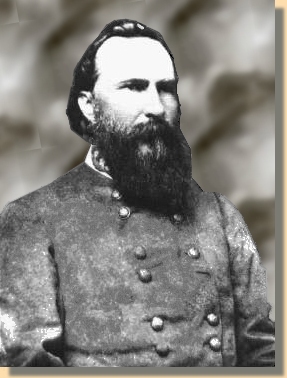 159 159
JAMES LONGSTREET
1821 - 1904
| |
James Longstreet was born in Edgefield, South Carolina on January 8, 1821. His
father, also named James, nicknamed him "Pete". His father died when James was
twelve. Although he was born in South Carolina, Longstreet considered Georgia his
home. He was raised and educated there.
Longstreet was appointed to West Point Military Academy from the state of Alabama
in 1838, where he met Ulysses S. Grant. After he graduated in 1842, Longstreet
was assigned, along with Grant, to the Fourth Infantry at Jefferson Barracks,
Missouri. It was there that he introduced his cousin, Julia Dent, to Grant. The
two were soon married.
After the Mexican war, in which he received a wound to the thigh, Longstreet
married Marie Louise Garland, the daughter of one of his former commanders.
THE CIVIL WAR
At the battle of
First Manassas, July 1861, Longstreet's
troops defended Blackburn's Ford. He was appointed Major General in October,
1861.
In early 1862, Longstreet suffered a serious personal loss when three of his
children died of scarlet fever during an epidemic in Richmond. The tragedy
affected him deeply.
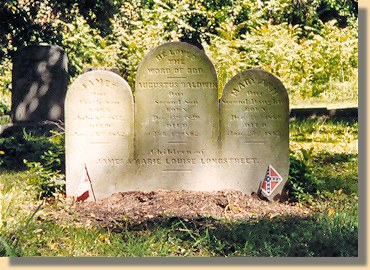
Longstreet's Children's Marker at
Hollywood Cemetery in Richmond, Va.
JAMES
Our
Fifth Son
Born
Jul. 8, 1857
Died
Jan. 26, 1862
|
HE LOVED
THE
WORD OF GOD
AUGUSTUS BALDWIN
Our
Second Son
Born
Dec. 15, 1850
Died
Feb. 1, 1862
|
MARY ANN
Our
Second Daughter
Born
Dec. 31, 1860
Died
Jan. 25, 1862
|
Children of
JAMES AND MARIE LOUISE LONGSTREET
|
In April, 1862, commanding a division, Longstreet conducted a rear guard action
near Williamsburg during McCellan's approach to Richmond during Peninsula
campaign . .
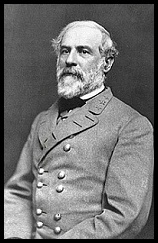
Robert E. Lee 1
After Confederate General Johnston's injury,
Robert E. Lee took command and formed the Army of
Northern Virginia .
Longstreet and Lee
developed a friendship that lasted until Lee's death in 1870. .
Longstreet and Lee
developed a friendship that lasted until Lee's death in 1870.
During the Seven Days battles around Richmond (June 25-July 1, 1862), Longstreet
demonstrated his courage and willingness to fight.
At the
Second Battle of Manassas on August
29-30, 1862 he launched a massive counterattack on the second day
of fighting which forced Pope's army on the second day
of fighting which forced Pope's army to retreat
toward Washington. to retreat
toward Washington.
During the Confederate invasion of Maryland in September of 1862 Longstreet's
forces came to D. H. Hill's aid at South Mountain and he and his men were heavily
involved at the
Battle of Sharpsburg (Antietam).
Lee recommended Longstreet for a promotion to Lieutenant General on October 11,
1862, and gave him command of the newly formed I Corps . .
In December, he and his corps played a leading role in Union General Burnside's
disastrous repulses on Marye's Heights at
Fredericksburg.
In early February of 1863, Longstreet was sent to gather and secure supplies in
what was to become known as the Suffolk Campaign. Although he gathered a fair
amount of the available supplies, and held up the Union forces, he failed to
expel the Union from the area. The
Battle of Chancellorsville
took place before Longstreet and his command could rejoin Lee.
Prior to the
Battle of Gettysburg, Longstreet
offered a plan to the Richmond government designed to relieve pressure on
Vicksburg. His plan was not
adopted, that June, in favor of Lee's plan to invade the North. Lee's plan was
designed to, relieve Virginia of Union troops, giving farmers time to bring in
their crops; threaten Northern Cities convincing the Union government that a
continued war was useless; and relieve other parts of the Confederacy by causing
Union armies in the west to move east.
Reacting to the Army of Northern Virginia moving north, the Army of the Potomac moved faster than Lee had expected. The two armies met at Gettysburg.
moved faster than Lee had expected. The two armies met at Gettysburg.
After the results of Second Manassas and Fredericksburg, Longstreet felt that
being on the defensive was the best way to fight the enemy. Accordingly, he told
Lee that offensive attacks on the Federal position along Cemetery Ridge were
doomed to failure. He preferred to flank the Union line and establish a
defensive position somewhere between the Army of the Potomac and Washington.
He felt that Meade would then be forced to attack a well-established
Confederate line with results similar to Fredericksburg.
Because Lee rejected his appeal, some writers have concluded that Longstreet did
not give full attention to his command and only reluctantly ordered Pickett's
charge, as ordered by Lee, on July 3., leaving it up to a Colonel, --- Colonel
Alexander, Commander of the Confederate Artillery --- to decide when
Longstreet's forces should attack.
(Although I feel the case has not been made against Longstreet at Gettysburg,
Longstreet's disagreement with Lee, and his subsequent actions, would later be
used in the controversy regarding who was responsible for the South losing the
war. - Ed.)
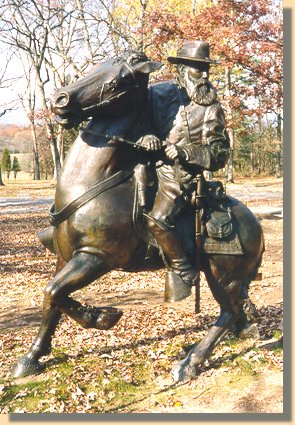
CSA General James Longstreet Monument at Gettysburg
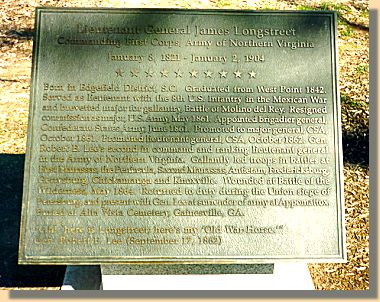
Longstreet Monument Plaque
Click
Here to read text.
|
|
PAGE TWO
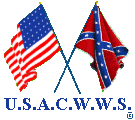 >
Civil War Photos
>
James Longstreet
>
Page 2
>
Civil War Photos
>
James Longstreet
>
Page 2
Notes
|
|



